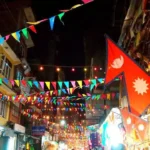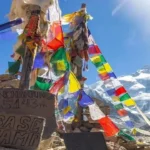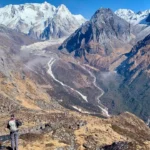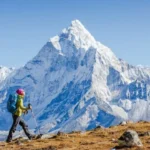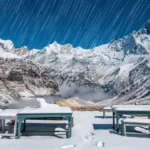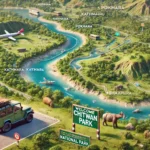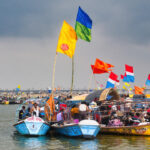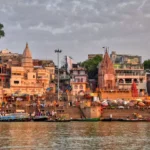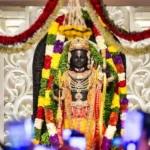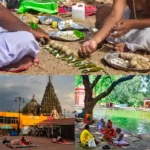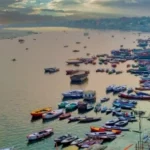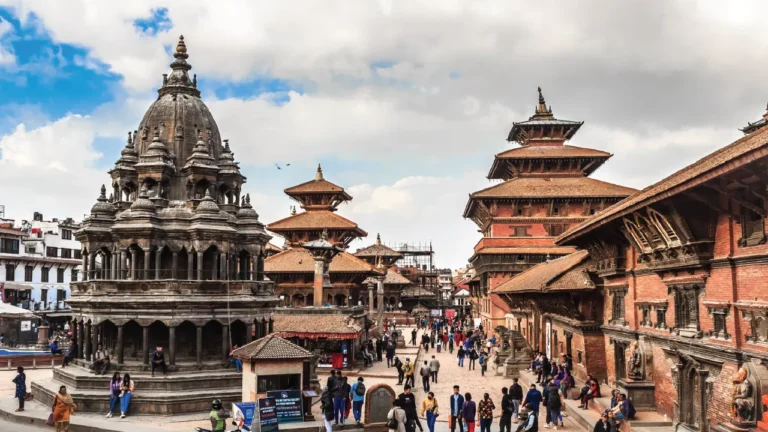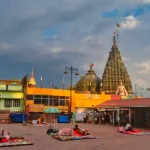Best Time to Visit Gosaikunda Lake
The experience of Gosaikunda changes with the seasons — from a serene, snow-covered sanctuary in winter to a vibrant pilgrimage hub in summer. Choosing the right time to visit depends on whether you’re going for a religious festival, clear mountain views, or quiet spiritual solitude.
🌕 Peak Time: Janai Purnima (August Full Moon)
- Why go: This is the most auspicious and spiritual time to visit. Thousands of Hindu pilgrims and sadhus from Nepal and India make the journey to bathe in the lake.
- Atmosphere: Vibrant, crowded, spiritually charged
- Weather: Monsoon season—expect rain and slippery trails, but pilgrims still brave the elements for the holy bath.
🌤️ Best Trekking Weather:
✅ Pre-Monsoon (March-May)
- Highlights: Clear skies, blooming rhododendrons, comfortable temperatures
- Trail Condition: Dry and safe
- Pilgrim Flow: Moderate — ideal for those who want a peaceful spiritual experience with good weather
✅ Post-Monsoon (September–November)
- Highlights: Crystal-clear Himalayan views, fresh air, and stable weather
- Trail Condition: Excellent
- Pilgrim Flow: Light to moderate — great balance of spirituality and scenery

❄️ Winter (December–February)
- Not recommended for most pilgrims
- Gosaikunda is usually frozen and the trails may be covered in snow.
- Best left for experienced high-altitude trekkers or those seeking solitude, not rituals
🔄 Quick Summary:
| Season |
Conditions |
Ideal For |
| Aug (Janai Purnima) |
Sacred festival, crowded |
Pilgrims & ritual bath seekers |
| Mar-May |
Warm, clear, flowers |
Trekkers & peaceful pilgrims |
| Sep–Nov |
Best views, stable weather |
Trekkers & spiritual explorers |
| Dec–Feb |
Harsh, snowy, risky |
Solo trekkers with winter skills |
Cultural Experience Along the Way – Gosaikunda Lake
The Gosaikunda pilgrimage isn’t just about reaching a holy lake—it’s a walk through the living culture of the Himalayas. As you ascend through the Langtang region, you’ll pass through villages inhabited by the Tamang and Sherpa communities, whose lives are closely tied to the land, the mountains, and the spiritual beliefs of the region.
🏘️ Tamang & Sherpa Villages
- Most of the villages along the route—like Dhunche, Sing Gompa and Chandanbari—are home to Tamang people, an ethnic group with deep Tibetan Buddhist roots.
- You’ll encounter prayer flags, mani walls (stone carvings with mantras), and Buddhist stupas throughout the trail.
- In some spots, you’ll also meet Sherpa families, especially if you take extended routes like Helambu.
🧀 Chandanbari (Sing Gompa) – A Unique Stop
- Known for its cheese factory, run by local monks and villagers
- A peaceful monastery here is open to visitors—a great spot for quiet prayer or meditation.
🍛 Local Food Experience
- Expect hearty meals like:
- Dal Bhat (rice and lentils)
- Tsampa (roasted barley flour)
- Tibetan bread and butter tea
- Yak cheese and momos
- Most tea houses are family-run and meals are simple, warm, and filling—especially after a long day’s walk.
🙏 Religious Harmony
- On the Gosaikunda trail, Hindu and Buddhist symbols coexist beautifully.
- It’s common to see Hindus bowing to Buddhist shrines, and Buddhist monks assisting Hindu pilgrims.
- This spiritual openness is a beautiful reminder that faith transcends form in these mountains.
🎉 Festivals & Community Life
- During Janai Purnima, entire villages participate—hosting pilgrims, setting up stalls, and organizing cultural programs.
- Outside of the festival period, the villages remain calm, spiritual, and welcoming, giving visitors a more authentic cultural connection.
What to Pack & How to Prepare – Gosaikunda Lake
Whether you’re trekking for spiritual reasons or the Himalayan experience, proper preparation is key to making your Gosaikunda journey safe, comfortable, and spiritually fulfilling. The terrain is challenging, and the weather can change fast—especially at high altitudes.
🎒 Essential Packing List
🧥 Clothing (Layered is key)
- Thermal base layers (top & bottom)
- Fleece or wool mid-layer
- Down jacket (for freezing nights)
- Waterproof windbreaker/rain jacket
- Trekking pants + extra pair
- Warm hat, gloves, scarf
- Trekking shoes (well-broken-in)
- Extra socks (preferably wool)
- Sunglasses & suncap
🛌 Personal Gear
- Daypack (20–30L) for essentials
- Sleeping bag (if staying in basic lodges)
- Water bottles or hydration pack
- Headlamp/torch with spare batteries
- Walking sticks/trekking poles (very helpful on steep climbs)

🧴 Toiletries & Personal Care
- Sunscreen (SPF 30+)
- Lip balm with SPF
- Wet wipes & tissues
- Toothbrush, paste, small towel
- Hand sanitiser
- Soap (biodegradable)
🩺 Basic First Aid
- Paracetamol / Ibuprofen
- Altitude sickness tablets (Acetazolamide if recommended)
- ORS (oral rehydration salts)
- Band-aids, antiseptic cream, blister patches
- Any personal medication
🧘♂️ Spiritual Items (Optional but meaningful)
- Mala (prayer beads)
- Shiva idol or photo
- Puja samagri (incense, camphor, flowers for rituals)
- Empty bottle for carrying Gosaikunda water home
🧠 Mental & Physical Preparation
- Cardio training: Light jogging, walking uphill, or stair-climbing 2–3 weeks before your trek
- Practice carrying your backpack with weight.
- If new to trekking, consider short hikes near your home to build stamina.
⚠️ Acclimatization Tips
- Take it slow—don’t rush the ascent
- Stay hydrated (but avoid alcohol)
- Be aware of altitude sickness symptoms: headache, nausea, dizziness.
- Listen to your body and rest as needed.
🛌 Lodging & Food Readiness
- Most trekkers stay at basic tea houses—rooms are simple, with shared bathrooms.
- Electricity is limited, especially at higher altitudes (carry a power bank!)
- Food is warm, basic, and carb-heavy—perfect for trekkers!
Permits and Entry Requirements – Gosaikunda Lake
Whether you’re a pilgrim, trekker, or spiritual explorer, you’ll need a couple of official permits to access the Gosaikunda region, since it falls inside Langtang National Park. These permits help fund conservation and maintain the trails and local infrastructure.
🪪 1. Langtang National Park Entry Permit
- Required for all travellers entering the park area (which includes Gosaikunda)
- Can be obtained in Kathmandu or at the entry checkpoint in Dhunche
- Fee (as of 2024):
- NPR 3,000 for foreign nationals
- NPR 1,500 for SAARC nationals
- Free or discounted for Nepali citizens (with ID)
🧾 2. TIMS Card (Trekkers’ Information Management System)
- Helps authorities keep track of trekkers for safety and rescue
- Issued by the Nepal Tourism Board or trekking agencies
- Fee (as of 2024):
- NPR 2,000 for individual trekkers
- NPR 1,000 if travelling with a registered guide or group
🧍♂️ Where to Get These Permits
- Kathmandu:
- Nepal Tourism Board office (Bhrikutimandap)
- Trekking Agencies Association of Nepal (TAAN) office
- Dhunche:
- Park entry checkpoint (you can pay the national park fee here if not done earlier)

📌 Important Notes
- Carry 2 passport-sized photos for the TIMS card
- Always carry the permits with you during the trek—you may be asked to show them at multiple checkpoints.
- If you’re travelling with a tour or trek operator, they often arrange permits for you.
✅ Summary:
| Permit |
Cost |
Where to Get |
| Langtang National Park Permit |
NPR 3,000 (foreigners) |
NTB Office / Dhunche Checkpoint |
| TIMS Card |
NPR 2,000 (solo), NPR 1,000 (group) |
NTB / TAAN office |
Tips for a Safe and Soulful Journey – Gosaikunda Lake
The Gosaikunda pilgrimage is both physically demanding and spiritually rewarding. To truly absorb the experience, it’s important to travel mindfully, respectfully, and safely.
⚠️ Safety First: Trekking Tips
🌬️ Acclimatize Properly
- Don’t rush the trek — take your time to allow your body to adjust to the altitude.
- Spend a night at places like Sing Gompa or Lauribina before ascending to Gosaikunda.
💧 Hydration is Key
- Drink plenty of water, even if you’re not feeling thirsty.
- Avoid alcohol or smoking during the trek — it affects oxygen absorption.
🏥 Know the Signs of Altitude Sickness
- Common symptoms: Headache, dizziness, nausea, shortness of breath
- If symptoms worsen, descend immediately and inform your guide or locals for help.
📲 Stay Connected, When Possible
- Mobile network coverage is patchy, but Ncell or NTC SIM may work in some areas.
- Carry a power bank or solar charger as electricity is limited in higher villages.
🧘♂️ Spiritual & Cultural Etiquette
🙏 Respect Sacred Spaces
- Remove your shoes when visiting shrines or monasteries.
- Avoid shouting, loud music, or disturbing the peaceful atmosphere near the lake.
📸 Be Mindful When Taking Photos
- Always ask before photographing locals, especially during rituals or pujas.
- Some areas may have photo restrictions, particularly during Janai Purnima.
🕉️ Participate with Intent
- Carry a small offering (like incense, flowers, or ghee) if you plan to do puja.
- Join the parikrama (circumambulation) or take a quiet moment of reflection by the lake.
🧳 Travel Light, but Smart
- Don’t overpack. Bring only what you truly need, and keep your backpack manageable.
- If hiring a porter, pack respectfully — 15–20 kg max load is standard.
♻️ Be a Responsible Pilgrim
- Don’t litter—carry your trash with you until you reach disposal points.
- Avoid using plastic bottles—carry a reusable bottle and use purification tablets or boiled water.
💡 Bonus Tip: Travel with a Purpose
- Whether you’re trekking for faith, healing, or exploration, set your intention before the journey begins.
- You’ll be amazed how much deeper the experience feels when you walk with meaning.

FAQs about Gosaikunda Lake Pilgrimage
❓Is the Gosaikunda trek suitable for beginners?
Yes, if you’re reasonably fit and take your time with acclimatization. It’s a moderate trek—no technical climbing involved, but the altitude makes it physically demanding.
❓How long does it take to reach Gosaikunda?
From Kathmandu to Gosaikunda and back, the standard trek takes 5 to 7 days. You can extend it if you take a longer scenic route or combine it with Helambu or Langtang Valley.
❓Can I do the pilgrimage without a guide?
Yes, but it’s recommended to take a guide for first-timers or those unfamiliar with high-altitude trekking. Guides also enhance the spiritual and cultural experience by offering context and safety.
❓Is Gosaikunda only for Hindus?
Not at all! While it holds strong significance in Hinduism, Buddhists also revere the site. Even non-religious trekkers visit for the natural beauty and the calm energy of the place.
❓Do I need trekking gear, even as a pilgrim?
Yes. Regardless of your purpose, the terrain is mountainous and the weather can be harsh. Warm clothes, trekking shoes, and layers are a must, even during summer.
❓Is the lake safe to bathe in?
Yes, but the water is cold year-round. Bathing is done more during Janai Purnima when pilgrims take the sacred dip as a ritual. Be cautious and aware of your health if planning to bathe.
❓Can elderly pilgrims complete the trek?
It depends on their fitness level. Many elderly devotees do the trek, often with the help of porters, horses, or extra rest days. Consult a doctor beforehand and ascend slowly.
❓Are there accommodations on the route?
Yes — basic tea houses are available along the trail, offering simple rooms, meals, and warmth. Booking is usually not required except during Janai Purnima when it gets crowded.
❓Can I combine Gosaikunda with other treks?
Definitely. You can link it with the Langtang Valley Trek or take the Helambu route for a longer and more immersive Himalayan experience.









